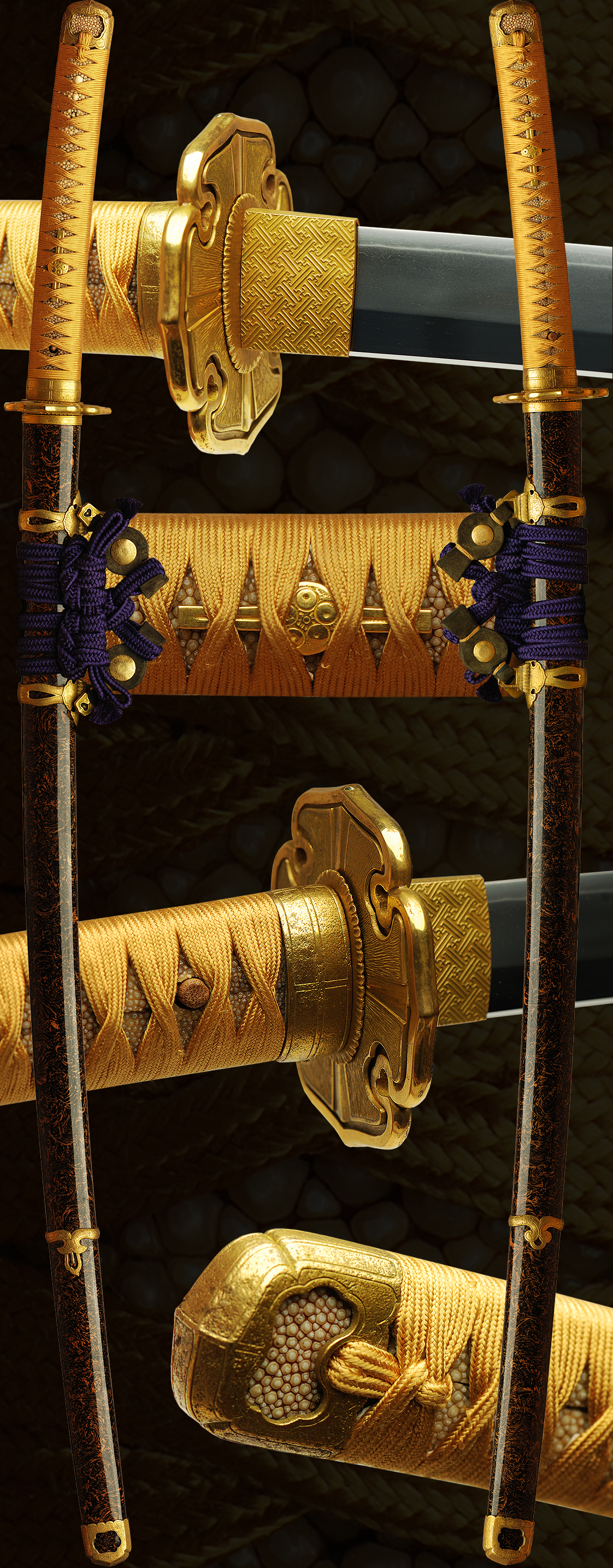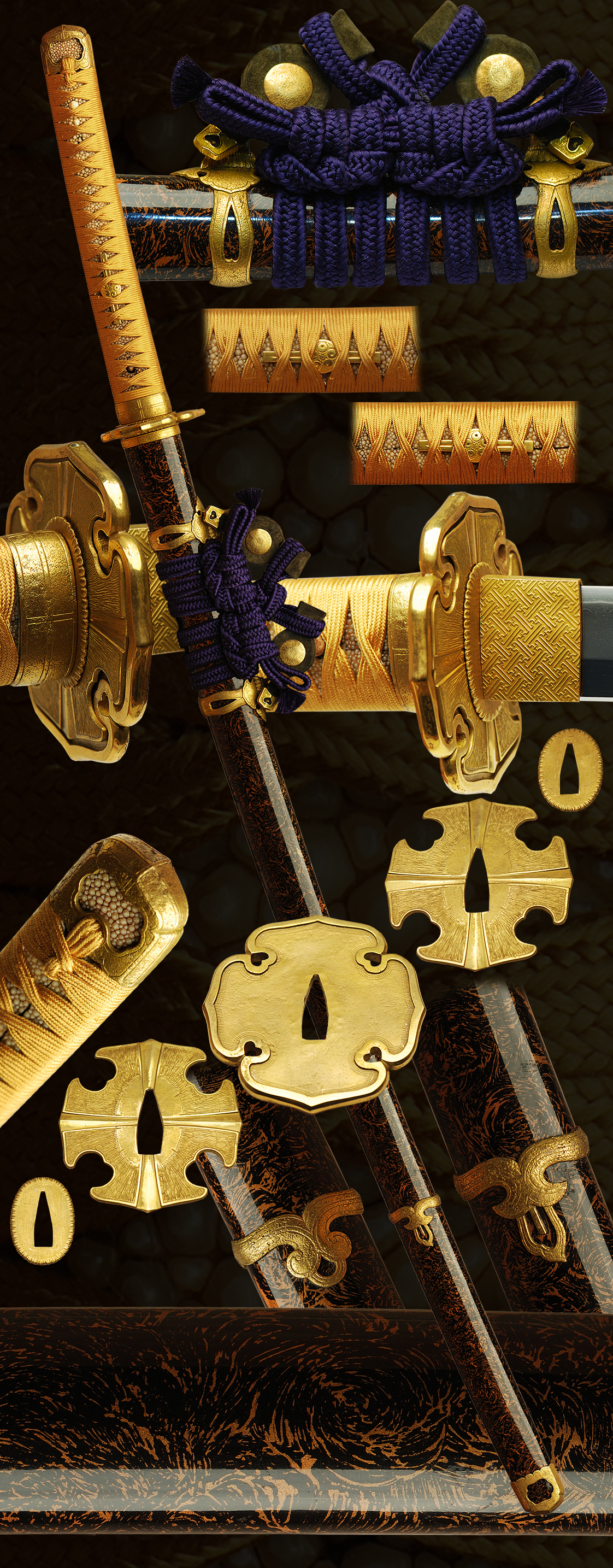This is a very special sword forged by “Shindō Minamoto Yoshikuni”. This blade at almost 30” and could be considered a ShinShinto masterpiece. The sword is signed and dated and origami issued. The swords forging produces a very tight itame with some swirling mokume by the ha covered in ji-nie. The hamon is a very nicely controlled Sugu-ba with much utsuri to be seen. There are puffs of shirake covering the blade like wisps of smoke rising above a tranquil stream.The habuchi is finished in a beautiful nioi–guchi. Chikei abounds and produces a striking effect. There is a longish boshi with an almost hakikake finish.
The saya/lacquer is made with swirling patterns of lacquer. The hangers with leather (possibly Doe skin) straps are in good shape. The ito-maki tachi mounts were used as described and most likely presented to a very special official or a shrine. This special sword was most likely paired with the mounts. The sword is in shirasaya also with a deeply rich honoki finish showing its age and beauty. There is tsunagi or wooden sword for the mounts. ITO-MAKI TACHI mounts also called ceremonial tachi and were most likely only worn by a ranking official. This ITO-MAKI style tachi mounts are very special as the entire tachi fittings are gilded in gold from top to bottom. Ito-maki tachi were made from Koto through Showa times. There is a gold gilded foil habaki with a some times referred to as key fret design. The menuki are of the Maeda mon. The tachi sageo is a deep purple in color.
(The origins of the Maeda clan is not known, though in Toshiie’s time it was said they descended from Sugawara Michizane, hence the plum-blossom family crest. However, historically they came from the village of Arako (now in Nagoya City) in Owari province. Maeda Toshiie served Oda Nobunaga, fighting under Nobunaga’s general Shibata Katsuie in the Hokuriku, and was given land in Echizen province, then in Noto province. After surrendering to Hideyoshi in 1583 he was given land in Kaga province that included Kanazawa. Kanazawa was to the the seat of the clan for almost 300 years. In 1585 he was also given land in Etchû province. Toshiie’s son Toshinaga sided with Tokugawa Ieyasu during the Sekigahara campaign and received the areas of Kaga that he did not have already. Thus, during the Edo period the Maeda clan ruled the three provinces of Kaga, Noto, and Etchû, which meant that their kokudaka was over one million koku (百万石), the largest among the daimyô. When Maeda Toshitsune retired he established branch houses through two of his younger sons and created sub-fiefs for them–Daishôji 大聖寺 (70,000 koku) in Kaga and Toyama 富山 (100,000 koku) in Etchû. These fiefs continued thus until the Meiji Restoration.The Maeda clan was a tozama clan, but it was considered close to the shogunate, and the head was entitled to use the name “Matsudaira,” the name of Tokugaeswa branch families, ceremonially.”)
- Mei: Shindô Minamoto Yoshikuni kore o tsukuru (新藤源義国造之)
- Date: Keiô gannen hachigatsu hi (慶応元年八月日, “on a day in the eighth month of Keiô one [1865]”)
- Nagasa: 29-15/16 inches
- Sori: 9.5 mm
- Width at the ha-machi: 32.50 mm
- Width at the yokote: 23.2 mm
- Thickness at the mune-machi: 7.8 mm
- Construction: Shinogi zukuri
- Mune: Iori
- Nakago: Ubu
- Kitae: Itame/mokume
- Hamon: Suguba
- Boshi: Maru
- Condition: Good polish
YOSHIKUNI (義国), 7th gen., Kaei (嘉永, 1848-1854), Ōshū – “Shindō Minamoto Yoshikuni” (新藤源義国), “Shindō Kojirō Yoshihiro” (新藤小次郎義広), real name Shindō Kojirō (新藤小次郎), he was the adopted son of the 6th gen. Yoshikuni and changed his name later from Yoshihiro (義広) to Yoshikuni (義国), he died on the eleventh day of the fourth month Meiji one (明治, 1868)
Email us if your interested in this item and remember to include the order number for this item: fss-745.
kantei-sho (鑑定書) – Appraisal
Shindô Yoshikuni (新藤義国)
shôshin (正真) – Authentic
nagasa 2 shaku 5 sun 2 bu kore ari (長さ弐尺五寸弐分有之) – Blade length ~ 76.3 cm
Heisei 25 nen 8 gatsu 4 nichi (平成二十五年八月四日) – August 4th 2013
Nihon Tôken Hozon Kai (日本刀剣保存会) – NTHK
No 17,929
meibun (銘文) – Signature: Shindô Minamoto Yoshikuni kore o tsukuru (新藤源義国造之)
Keiô gannen hachigatsu hi (慶応元年八月日, “on a day in the
eighth month of Keiô one [1865]”)
kitae (鍛) – Forging: ko-itame
hamon (刃紋) – Hardening: suguha
bôshi (鋩子) – Hardening in tip: sugu with a ko-maru-kaeri
chôkoku (彫刻) – Engravings:
nakago (中心) – Tang: mekugi-ana (目釘穴) 1, yasurime (鑢): sujikai with a prominent start of file marks
bikô (備考) – Remarks: Mutsu province
shinsa’in natsu’in (審査員捺印) – Seals of Judges: 4 seals
For Sale


























